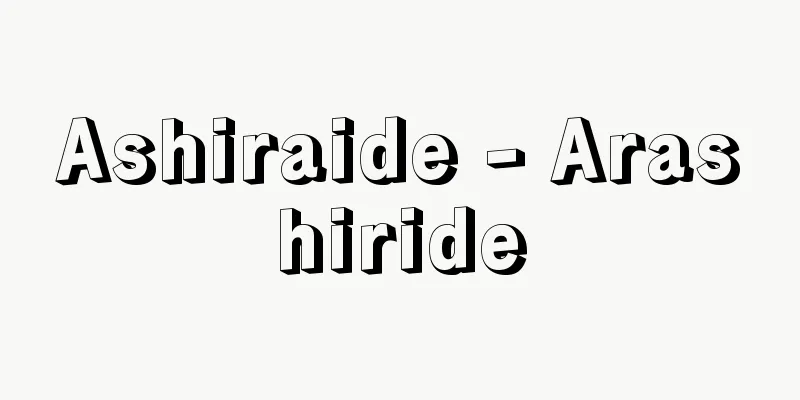Ashiraide - Arashiride

|
There are many kinds of deitagoto, but they can be broadly divided into three categories: o-komono (large-scale plays) played mainly with o-tsuzumi and ko-tsuzumi drums, taikomono (drum-playing plays) which also include taiko drums, and other plays. O-komono includes the most commonly used shidai (stage plays) for a variety of roles, including men and women (except for the elderly), nobles and common people, and monks and laypeople; shin-no-shidai (sincerity plays) in which the waki and wakizure of waki-noh play make a dashing appearance, as in Arashiyama, Kamo, and Takasago; itsei (a single voice) for characters such as incarnations, ghosts, and spirits, as well as shin-no-ichi-sei (sincerity plays) in which the mae-jite and tsure of waki-noh play such as the elderly make a solemn appearance; and ashirai-de (a play in which the shite appears without anyone noticing, as in Kinuta and Kumano). Taikomono include "Deha," used for the entrance of non-human characters such as gods, Buddhas, devils, and spirits, as in "Ama," "Satsushoseki," and "Nomori," "Oobeshi," in which tengu and other deities with strange features appear in a grand manner, as in "Kurama Tengu," "Sagariha," in which heavenly immortals appear elegantly, as in "Shojo" and "Xiwangmu," and "Shinnoraijo," used for the entrance and seating of Tang Dynasty emperors, as in "Kantan" and "Tsurukame." *Some of the terminology explanations that refer to "Ashirai De" are listed below. Source | Heibonsha World Encyclopedia 2nd Edition | Information |
|
… 出端事は種類が多いが,おもに大鼓(おおつづみ)・小鼓(こつづみ)で奏される大小物と,太鼓が加わる太鼓物,その他のものの三つに大きく分けられる。大小物には,老人を除く男女,貴賤,僧俗などさまざまな役に用いる最も使用例の多い〈次第(しだい)〉,《嵐山》《賀茂》《高砂》など脇能のワキ・ワキヅレがさっそうと登場する〈真ノ次第〉,おもに化身,幽霊,精などの役に用いる〈一声(いつせい)〉(〈次第〉と同様に使用例が多い),老人など脇能の前ジテ・ツレが荘重に登場する〈真ノ一声〉,《砧(きぬた)》《熊野(ゆや)》などでいつのまにかシテが登場していたという趣の〈アシライ出〉などがある。 太鼓物には,《海人(あま)》《殺生石》《野守(のもり)》など,神仏,鬼畜,精などの非人間的な役の登場に用いる〈出端〉,《鞍馬天狗》のように天狗や異相の神などが豪壮に登場する〈大(おお)ベシ〉,《猩々》《西王母》など天仙が風流的に登場する〈下リ端(さがりは)〉,《邯鄲》《鶴亀》など唐人の帝王の登場や着座に用いる〈真ノ来序〉などがある。… ※「アシライ出」について言及している用語解説の一部を掲載しています。 出典|株式会社平凡社世界大百科事典 第2版について | 情報 |
<<: Ashira Junior High School - Ashira Junior High School
Recommend
Isa medicine - Isabaiyaku
…From the end of ancient times to the Middle Ages...
Organdy processing - Organdy processing
…Also, concentrated sulfuric acid or cold caustic...
Yomogita [village] - Yomogita
A village in Higashitsugaru District, northwest of...
MACE - Meisu
Abbreviation for Macintosh Audio Compression and E...
Miracle play - miracle play (English spelling)
A type of religious drama from the Western Middle...
Rana brevipoda porosa (English name) Ranabrevipodaporosa
… [Takahiro Matsui]. … *Some of the terminology t...
Princess Fuwa - Princess Fuwa
Year of birth: Unknown An 8th century princess. Da...
Thirty Gods - Sanjuubanjin
The term refers to the 30 famous gods in Japan wh...
Automatic description
The act of writing or creating text as quickly and...
Okehampton
...There are many Bronze Age ruins, and in the Mi...
Warty crab - Warty crab
…In some areas, it is eaten. The P. tuberculata ,...
Helicoprion - Helicoprion
A fish of the genus Helicoprion in the family Aga...
Arata - Koden
Under the ancient Ritsuryo system, this refers to...
Browning phenomenon - browning
Browning is the process by which animals, plants,...
divi-divi (English spelling) dividivi
…Also, C. coriaria (Jacq.) Willd., native to the ...









